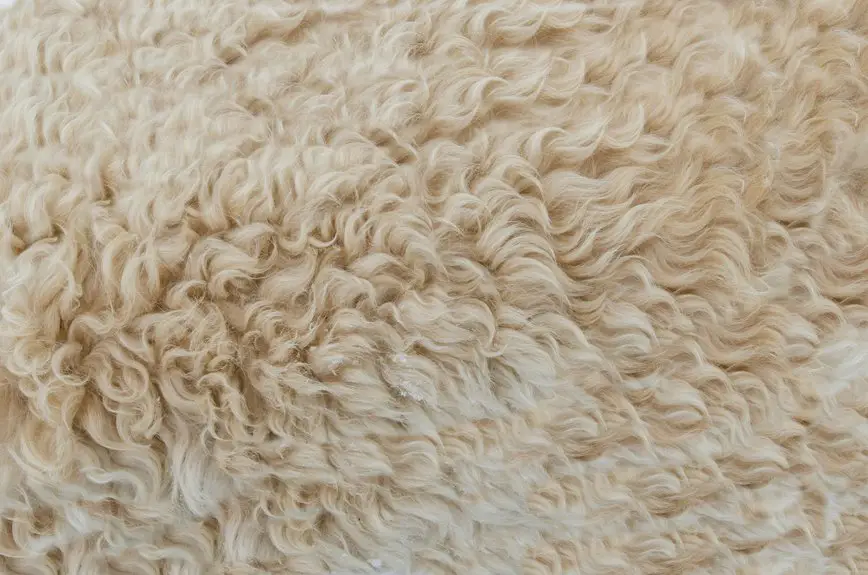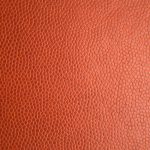You’ll find bouclé fabric offers a cozy, inviting softness thanks to its looped yarns made from fibers like wool, cotton, or silk. Its textured surface feels nubby rather than smooth, giving you warmth and tactile appeal that’s different from typical cotton or velvet. The softness varies with the fiber blend and loop size, so it’s not just plush but also visually interesting. Keep exploring, and you’ll discover how to care for and best enjoy bouclé’s unique feel.
Table of Contents
Key Takeaways
- Bouclé fabric is soft with a unique, nubby texture created by looped and curled yarns for a cozy, tactile feel.
- It combines fibers like wool, cotton, silk, and synthetics, influencing softness, warmth, and durability.
- Bouclé softness varies by fiber content, loop size, yarn twist, and weaving techniques used in its construction.
- Unlike smooth velvet, bouclé offers a textured softness that feels warm and inviting, ideal for outerwear and upholstery.
- Proper gentle care, including mild detergents and careful washing, is essential to maintain bouclé’s softness and texture.
What Is Bouclé Fabric Made Of?
Bouclé fabric combines various fibers to create its distinctive looped texture. When you look closer, you’ll find that it often includes wool, cotton, silk, or synthetic fibers like polyester.
These materials work together to give bouclé its durability and softness. You might be surprised to learn that the blend of fibers affects how the fabric feels and performs. Wool adds warmth and resilience, while silk brings a subtle sheen and smoothness.
The blend of fibers enhances bouclé’s durability, warmth, softness, and a subtle sheen for a unique texture.
Cotton provides breathability, making it comfortable to wear, and synthetics contribute to elasticity and easy care. By mixing these fibers, manufacturers tailor bouclé to suit different uses, whether for cozy upholstery or stylish garments.
Understanding what bouclé is made of helps you appreciate its versatility and unique feel.
The Distinctive Texture of Bouclé Yarn
The unique feel of this fabric comes from the way its yarn is crafted. Bouclé yarn features loops and curls formed by twisting multiple strands together unevenly. This irregular construction gives the fabric its characteristic bumps and texture you can both see and feel. When you touch bouclé, you notice its tactile dimension, unlike smooth yarns.
Here’s a quick look at bouclé yarn’s distinctive features:
| Feature | Description | Effect on Texture |
|---|---|---|
| Loop Size | Small to medium loops | Creates a bumpy surface |
| Yarn Twist | Uneven twisting of strands | Adds curls and volume |
| Strand Count | Multiple strands combined | Enhances thickness |
This construction results in a cozy, textured fabric that stands out.
Comparing Bouclé Softness to Other Fabrics
When you feel bouclé, you’ll notice it’s softer than typical cotton but has a more textured surface.
Compared to velvet, bouclé offers a unique, nubby softness rather than the smooth, plush feel you’re used to.
Understanding these differences helps you choose the right fabric for your comfort and style.
Bouclé vs. Cotton Softness
Although cotton often feels familiar and gentle against your skin, bouclé offers a distinct softness that sets it apart.
When you touch bouclé, you’ll notice its characteristic looped yarns create a textured surface that feels both soft and slightly nubby. Unlike cotton’s smooth and consistent softness, bouclé’s texture provides a cozy, tactile experience that’s more dynamic.
You might find bouclé less uniformly soft but warmer and more inviting, especially for items like jackets or throws. Cotton, on the other hand, excels in breathability and straightforward softness, making it ideal for everyday wear.
Texture Comparison With Velvet
If you’ve appreciated bouclé’s unique softness compared to cotton, you’ll find its texture contrasts interesting when placed beside velvet.
Velvet feels smooth and plush, with a dense, even pile that gives it a luxurious softness. Bouclé, on the other hand, has a nubby, looped surface that feels textured and slightly bumpy to your touch.
While velvet invites your fingers to glide over its surface, bouclé offers a tactile experience with more dimension and character. You might find velvet softer in a conventional sense, but bouclé’s softness lies in its cozy, inviting texture that adds warmth without losing structure.
Both fabrics have their own appeal, so your choice depends on whether you prefer plush smoothness or textured softness.
Factors Affecting the Softness of Bouclé
Because bouclé fabric combines loops and twists, the materials and techniques used greatly influence its softness. When you choose bouclé, you’ll notice that the fiber type plays a big role—natural fibers like wool or cotton tend to feel softer than synthetic ones.
The size and tightness of the loops also matter; larger, looser loops create a plusher texture. How the yarn is spun can add softness or roughness, depending on whether it’s tightly twisted or gently spun.
Larger, looser loops enhance plushness, while gentle yarn spinning boosts softness in bouclé fabric.
Finally, finishing treatments like brushing or washing can soften the fabric further.
Here’s what affects bouclé’s softness:
- Fiber content (wool, cotton, acrylic)
- Loop size and density
- Yarn twist and ply
- Weaving technique
- Post-weaving finishing processes
Ideal Uses for Bouclé Fabric Based on Texture
When selecting bouclé fabric for a project, you’ll find its distinctive texture guides its best uses. Its soft, looped surface offers comfort and visual interest, making it perfect for cozy, tactile applications. You’ll want bouclé for upholstery, outerwear, and accessories where warmth and texture matter most.
| Use | Texture Effect | Emotional Appeal |
|---|---|---|
| Upholstery | Plush, inviting | Comfort & warmth |
| Outerwear | Soft, insulating | Cozy, stylish |
| Accessories | Textured, unique | Chic, tactile |
Choosing bouclé means adding both softness and character. It’s ideal when you want your project to feel as good as it looks, inviting touch and admiration.
Tips for Caring for Bouclé to Maintain Softness
To keep your bouclé fabric soft, you’ll want to wash it gently and store it properly.
Avoid using harsh chemicals that can damage the fibers.
With the right care, your bouclé will stay cozy and beautiful for a long time.
Gentle Washing Techniques
Caring for bouclé fabric requires a delicate touch, especially during washing, to keep its unique texture soft and intact. You want to avoid harsh agitation or hot water, which can damage the loops and cause stiffness.
Instead, follow these gentle washing techniques:
- Use cold or lukewarm water to prevent shrinking and fiber damage.
- Select a mild detergent designed for delicate fabrics.
- Hand wash or choose a gentle cycle on your washing machine.
- Avoid wringing; gently press out excess water instead.
- Lay flat to dry on a clean towel, reshaping the fabric as it dries.
Proper Storage Practices
Storing bouclé fabric properly plays an essential role in maintaining its softness and texture over time. When you put away bouclé items, avoid folding them tightly to prevent creases and fiber damage. Instead, hang garments on padded hangers to keep their shape intact.
Make certain the storage area is cool, dry, and away from direct sunlight, which can fade colors and weaken fibers. Use breathable garment bags or cotton covers to protect bouclé from dust while allowing air circulation. Avoid plastic bags, as they trap moisture and encourage mildew.
If you store bouclé items long-term, check them periodically to assure they remain fresh. By following these steps, you’ll preserve your bouclé’s unique texture and softness, keeping your pieces looking and feeling great for years.
Avoiding Harsh Chemicals
While keeping bouclé fabric stored properly helps maintain its texture, how you clean and treat it plays an equally important role.
Avoiding harsh chemicals is key to preserving bouclé’s softness and unique loops. Strong detergents, bleach, or fabric softeners can damage fibers, making the fabric rough and brittle. Instead, opt for gentle care methods that respect the delicate nature of bouclé.
Here’s how you can avoid harsh chemicals and keep your bouclé soft:
- Use mild, pH-neutral detergents specifically designed for delicate fabrics
- Skip bleach and fabric softeners that break down fibers
- Spot clean stains with a gentle solution, like diluted vinegar or baby shampoo
- Test any cleaning product on a hidden area before full use
- Rinse thoroughly to remove all detergent residue, preventing stiffness
Frequently Asked Questions
How Does Bouclé Fabric Hold up in Hot Weather?
Bouclé fabric can feel warm in hot weather due to its thick, textured loops. You might find it less breathable than lighter fabrics, so it’s better suited for cooler days or air-conditioned spaces to stay comfortable.
Can Bouclé Fabric Be Dyed Different Colors Easily?
You can dye bouclé fabric different colors, but its textured loops may absorb dye unevenly. For best results, choose natural fibers and use appropriate dyes to guarantee vibrant, consistent colors without damaging the delicate fabric.
Is Bouclé Fabric Hypoallergenic for Sensitive Skin?
You might think bouclé’s nubby texture irritates sensitive skin, but it often doesn’t. Since it’s usually made from natural fibers like wool or cotton, it can be hypoallergenic—just test it first to be sure it suits you.
What Is the Environmental Impact of Producing Bouclé Fabric?
You’ll find bouclé’s environmental impact varies by fiber type; natural fibers like wool are renewable but resource-intensive, while synthetics involve petrochemicals. Choosing sustainably sourced bouclé helps reduce its ecological footprint considerably.
Are There Famous Fashion Designers Known for Using Bouclé?
Back in the roaring twenties, Coco Chanel revolutionized fashion by using bouclé fabric. Today, you’ll find designers like Karl Lagerfeld and Gabriela Hearst embracing its unique texture, making your wardrobe timeless and chic.
- Does Chiffon Fabric Stink - July 15, 2025
- Does Chiffon Fabric Affect the Economy - July 15, 2025
- Does Cotton Fabric Have a Nap - July 15, 2025







